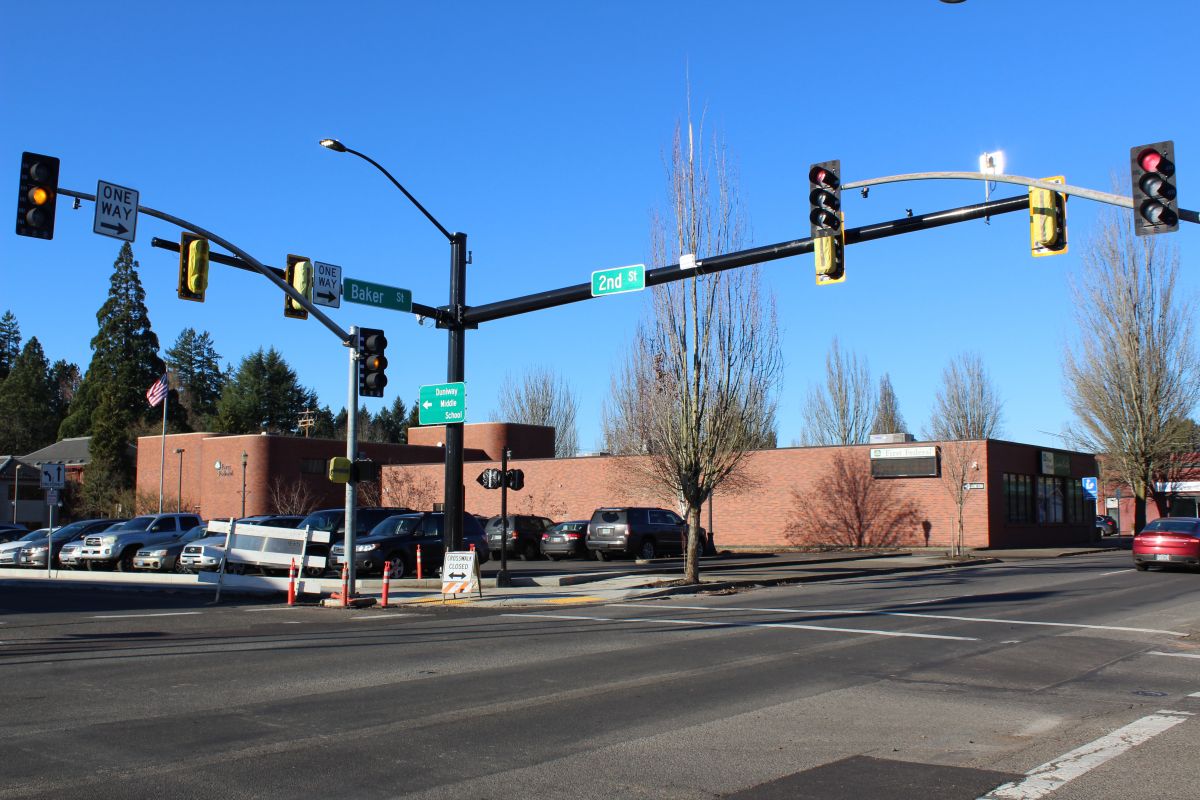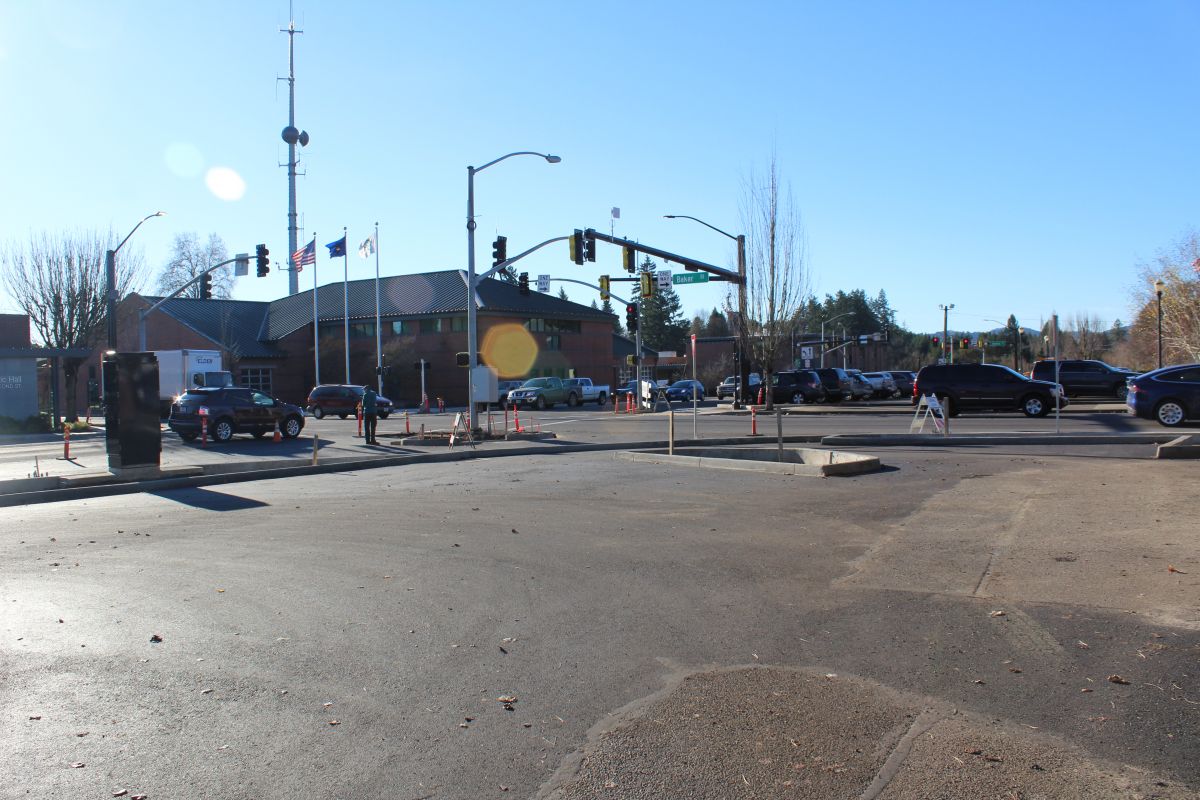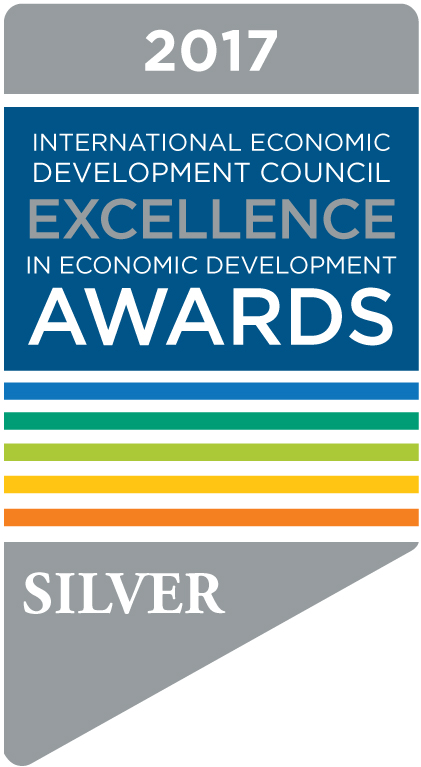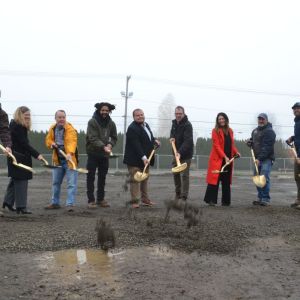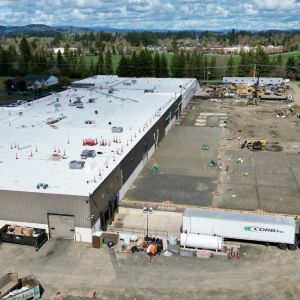MEDP Spark - Investing in Infrastructure: Transportation Improvements in McMinnville
Dec 14, 2017
MEDP Spark, Volume 2, Issue 12 - December 2017
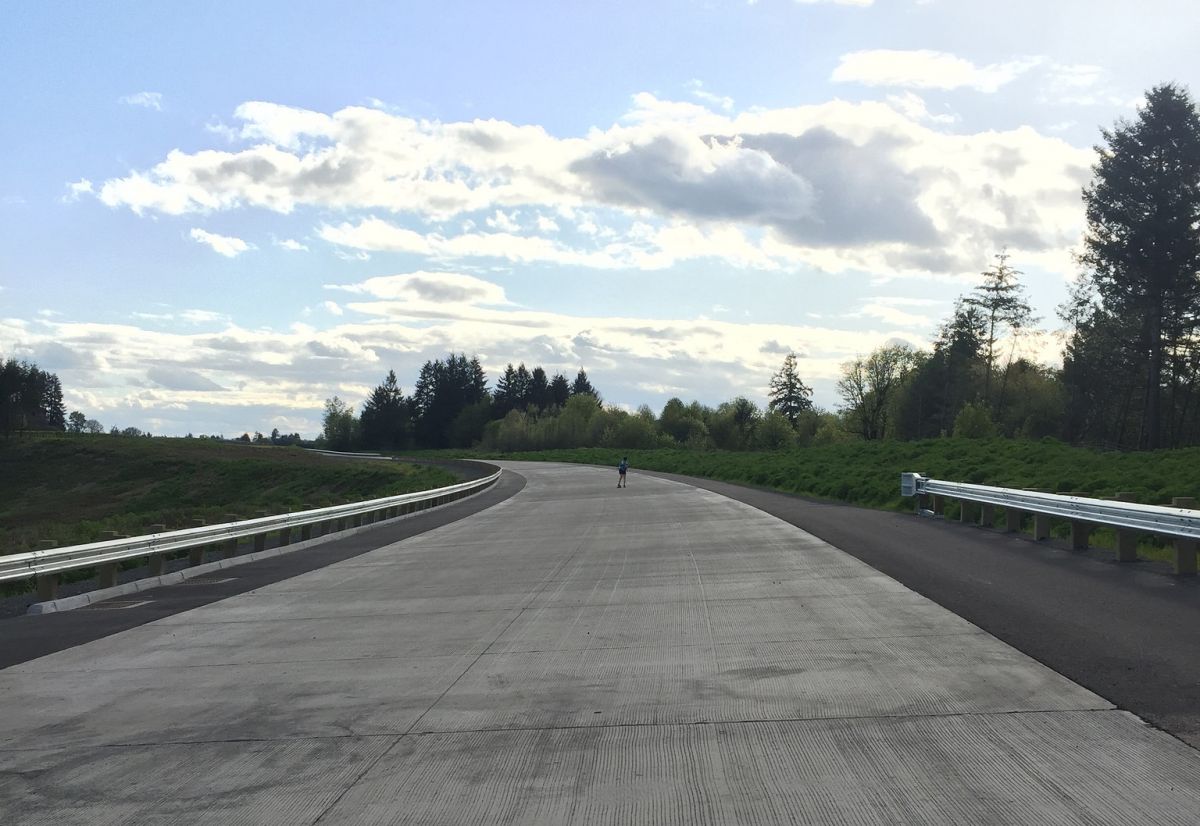
A paved stretch of the Newberg Dundee Bypass
Nearly 30 years ago a man named Dave Haugeberg began to spearhead a movement that wouldn’t truly begin to take physical form until ground was broken in 2013, 25 years later. The Newberg Dundee Bypass has been a long fought battle with an incredible amount of community support. With phase one set to be complete and open by the end of December 2018, the bypass is not the only project taking shape around us. You yourself may have experienced the delays that can always be looked at with the rose colored optimistic glasses of progress. Around the City of McMinnville ground is being broken and projects are being completed.
Here’s the thing about infrastructure: It is for everybody. No matter your age, location, or political affiliation, everyone must use roads to get from point A to point B. Infrastructure impacts how people get to work and how long it takes for them to get home from work which influences the time they can spend with friends and family. It impacts the efficiency of businesses and where they decide to locate their businesses, and it impacts how people choose to interact with their community. With large public sidewalks, safety measures put into place for pedestrians, and bike lanes, people are able to participate in a community in a different way.
Luckily, in McMinnville, decisions and money has been put in place to allow growth. With infrastructure improvements happening all over the city, we at MEDP wanted to update you on developments around town, at the McMinnville airport, and on the Newberg Dundee Bypass.
New street lights have been installed around town.
City Street Improvements
According to Mike Bisset, Community Development Director for the City of McMinnville, “This community has been supportive of infrastructure.” Bisset assures this is something that isn’t always common in communities, and has allowed McMinnville to grow at a relatively steady rate. Creating infrastructure improvements is a multi-year process. Many of the improvements you can see around town today are due to a study conducted from 2006 through 2010. The study revealed where the infrastructure plan needed to be updated and what the priorities were for improvement.
In 2015, the community demonstrated their commitment to transportation when McMinnville voted to approve a $24 million measure to improve transportation. This set a multitude of projects in motion that were all identified in the original study in 2006. Bisset comments on the bond stating “We’ve been lucky to have a lot of large capital projects with a small amount of conflict.” Bisset sees all of the projects as an investment in the city, “It’s a mix of capital projects that address current and future transportation needs.”
The transportation bond made it possible for the city to complete five capital improvement projects, multiple sidewalk and pedestrian safety projects and rehabilitation and repaving of 84 streets including 14 miles of road. Though the pedestrian improvement projects (particularly around the schools) are vastly important to the community and can be read about here, I’ll be focusing on the five capital improvement projects in the city.
5th Street Upgrades
The first project completed in the transportation bond, the 5th Street improvements between Lafayette Avenue and Adams Street, have had both visual and a traffic flow impact on those traveling through downtown. The construction included adding and upgrading traffic signals along the street, creating improved intersections with the addition of turn lanes, and creating a better sidewalks and crosswalks to encourage safer pedestrian traffic.
Not only are the lights improved, they were installed with infrared rather than on a fixed timing system like the previous signals. The infrared technology allows the lights to help with traffic flow and, “talk to each other because they’re all interconnected.” The project used $2.6 million of the bond and has already helped to ease congestion on 3rd Street by providing trucks and cars a new and efficient route.
2nd Street Improvements
Almost 90% complete, the 2nd Street improvements will have upgraded traffic signals with the same technology as the ones placed on Fifth Street, adding even more traffic flow as all of the lights will be able to talk to one another. Improvements will also include left-turn lanes and sidewalk and crosswalk work. Completion is fast approaching and the new traffic signals will be turned on soon.
The project cost a total of $2.1 million including $500k from the Oregon Department of Transportation (ODOT).
NE Alpine Avenue Development
One of the most visible projects being completed as part of the transportation bond is the improvements occurring along Alpine Avenue in the Northeast Gateway District. Alpine Avenue is set apart from other transportation improvements in the bond as its goal and affect with be far reaching to the area. According to Bisset, the project is being completed with pedestrians and community in mind. With a curbless street, street surfacing, pedestrian facilities, and landscaping, the project is designed to spark economic development in the area. Businesses are already enjoying the new “patio-like” feel that the newly surfaced streets are creating and buzz is surrounding available property and buildings. With McMinnville’s commitment to urban renewal, there are incentives available to businesses looking to locate in the area.
The project is 75% complete, expected to be finished in April 2018, and cost $4.4 million. $2.2 million of the project cost came from Urban Renewal Funds.
Old Sheridan Road Reconstruction
The only project in the bond yet to be started, the Old Sheridan Road improvements will include traffic signal upgrades, new turn lanes, bridge reconstruction, bike lanes, and sidewalk improvements. Currently, driving along the road provides lanes with no shoulders and turns that leave neighborhoods nervous. With improvements, not only will there be a better traffic flow, but the safety of drivers, bikers, and pedestrians will all be improved.
The project is budgeted at $3.2 million, is currently being designed based on consultant data, and is expected to be completed by late summer to fall of 2019.
NW Hill Road Widening
NW Hill Road has long been an area of concern for the neighborhoods and people who use the road daily. Driving by now, you will see a lot of dirt and what seems to be a lot of activity. With the widening of the road, which will include sidewalks and bike lanes, there will also be elements to improve safety and traffic flow. McMinnville will have its first roundabouts constructed at both Baker Creek Road and Wallace Road and the “S-curves” at Fox Ridge Road will be softened. The project shows a commitment to improving not only the traffic in McMinnville’s downtown, but also the neighborhoods that surround the core, giving everyone a better commute.
The project is currently 15% complete and is expected to completed in November 2018. The project is budgeted at $9 million for both design and construction. Wave to the crews as you pass by, as the project is in the early stages of improving our city.
McMinnville Municipal Airport
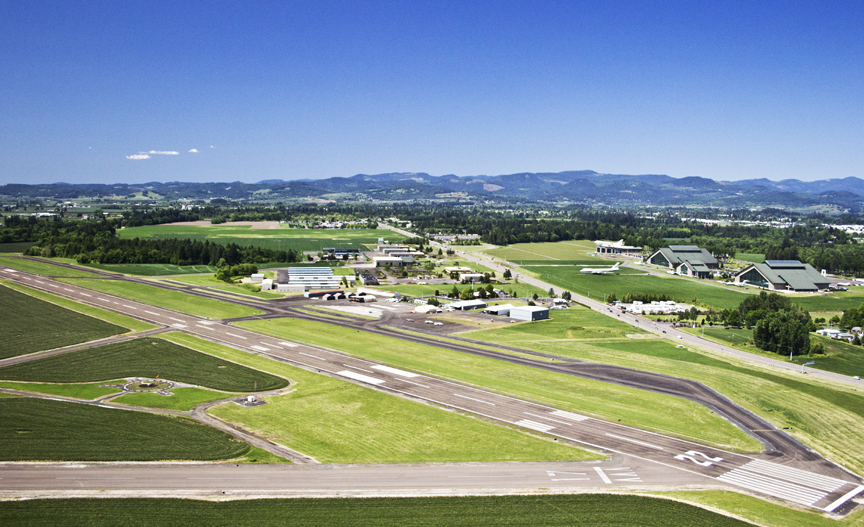
McMinnville’s airport is the third busiest in the Northwest region
The McMinnville Airport is important to the economic health of the community. Though often ‘out of sight, out of mind’ for many residents, according to 2012 statistics from the Oregon Department of Aviation the airport supports more than 2,500 jobs which equals a combined pay of more than $109 million. Total visitor spending associated with the airport is more than $377 million. Accordingly, the airport is important to the community. It’s the third most active regional airport in the Northwest region and essentially supports itself. No local property taxes go to supporting the airport, rather it’s self sustaining, except when it comes to large improvement projects.
The last time the airport was reconstructed was 1992. With two runways, the main runway needed to be repaved due to normal wear and tear. The runway repaving is a $8 million project. According to Bisset, 90% of the construction was funded by the Federal Aviation Administration which has been a partner for years, and the remaining 10% was funded by Connect Oregon, a lottery-backed bond initiative to invest in Oregon’s transportation, including air.
Bisset comments that repaving the runway not only makes it safer for planes for the next 20 years with new lighting, but will “set us up well for growth in the airport.” Construction has not come without challenges. Due to the Streaked Horned Lark, an endangered bird which has made nests in the gravel beside the runway, construction could only be done in certain areas of the airport in differing times. Even with the setbacks, the runway is set to be completed in January of 2018.
Newberg Dundee Bypass
Play on the Bypass - Drone Footage from JLA Involve on Vimeo.
The Newberg Dundee Bypass has been a 29 year goal that is finally reaching a visual fruition. Dave Haugeberg began the Yamhill County’s Parkway Committee in 1988 to start speaking about what a bypass from Dundee to Rex Hill could look like. What is set to be open by January 1, 2018, is the first phase of this process. Called lovingly by Haugeberg in a recent interview done by McMinnville Radio Station KLYC, “the people’s bypass” the process of creating the project has shown an incredible amount of community engagement and commitment.
Speaking to Tim Potter, Area Manager at ODOT, after years of discussion, creating community support, and trying to locate resources to create it, environmental work for the bypass began around the year 2000. Throughout the study, the question of money hung in the air. By 2011, when the document was completed, the Jobs and Transportation Act was passed which created the funding for phase one with support from Yamhill County, the Confederated Tribes of Grand Ronde, and surrounding cities. After design work was completed for phase one, in 2013 construction began. ODOT was strategic in their use of contractors, utilizing multiple contractors, all from the valley, to increase the speed of construction.
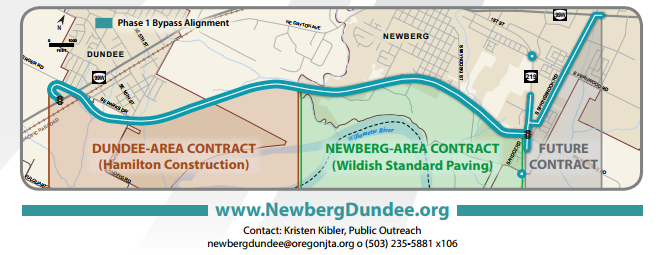
On December 18, 2017 at 2pm, a ribbon cutting is scheduled on the bypass, but cars will not be allowed on the road until later in the month. Contractors have until the end of the year to complete the work and finish the four mile bypass which starts at the South side of Dundee and ends at Springbrook Road in Newberg. According to Haugeberg, this first phase is a “band-aid” to the real problem. Eventually, the bypass will include a direct on-ramp in Dundee, which as of now is a “fish-hook” on ramp, and the road will stretch 11 miles to the base of Rex Hill.
The benefits of the bypass are vast including a decrease of traffic in Newberg by 20% and 40% in downtown Dundee. This should reduce travel times by up to 50-60%. The bypass is the first major highway to be created since I-205 was constructed. The second and final phase of the bypass is already in the process due to the timeliness and ODOT’s ability to budget the project correctly over 10 years ago. After completion of the first phase, the remaining budget will be spent on the design of the second phase as well as the purchase of right-of-ways for the future roads.
To create a project as large as the bypass it includes a huge cast of dedicated individuals and municipalities. This includes Yamhill County, the Confederated Tribes of Grand Ronde, the cities of McMinnville, Dundee, Newberg and Wilsonville, Clackamas County, Washington County, and the business community. Potter says the process has shown him what can happen when a community comes together, “all I can do is applaud the engineers and the people who did the work way back then.”
At MEDP, we are overjoyed by the progress and projects that are starting, nearing completion, and in the works surrounding us. With community members who are committed to creating a better future, we understand the legacy of those who came before us and those yet to come. A legacy that’s creating a future we can all enjoy. This is a common thread in McMinnville: community members who appreciate and understand the impact their current choices have on the future. We thank those who made these choices and are excited to continue to build towards a better future.

